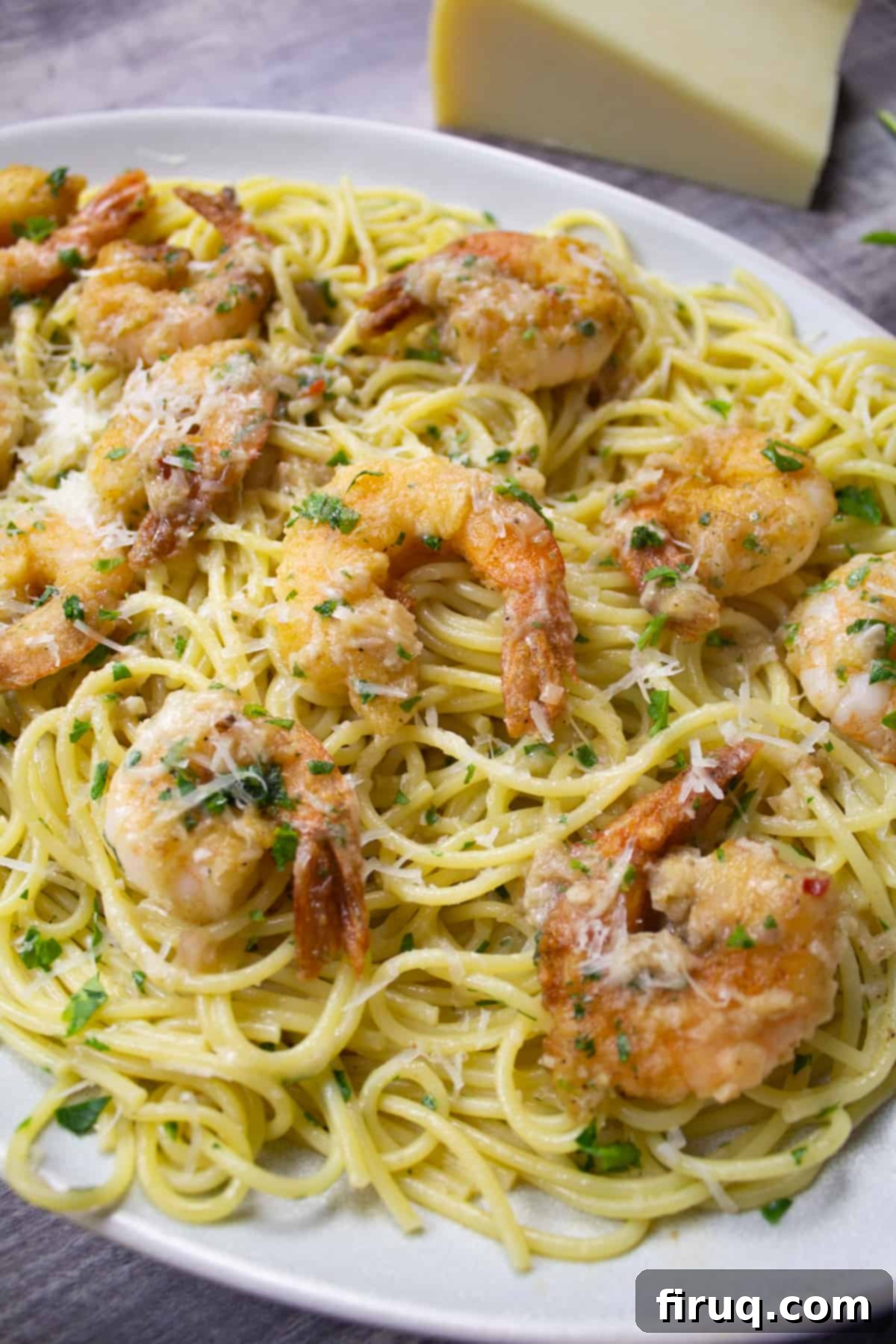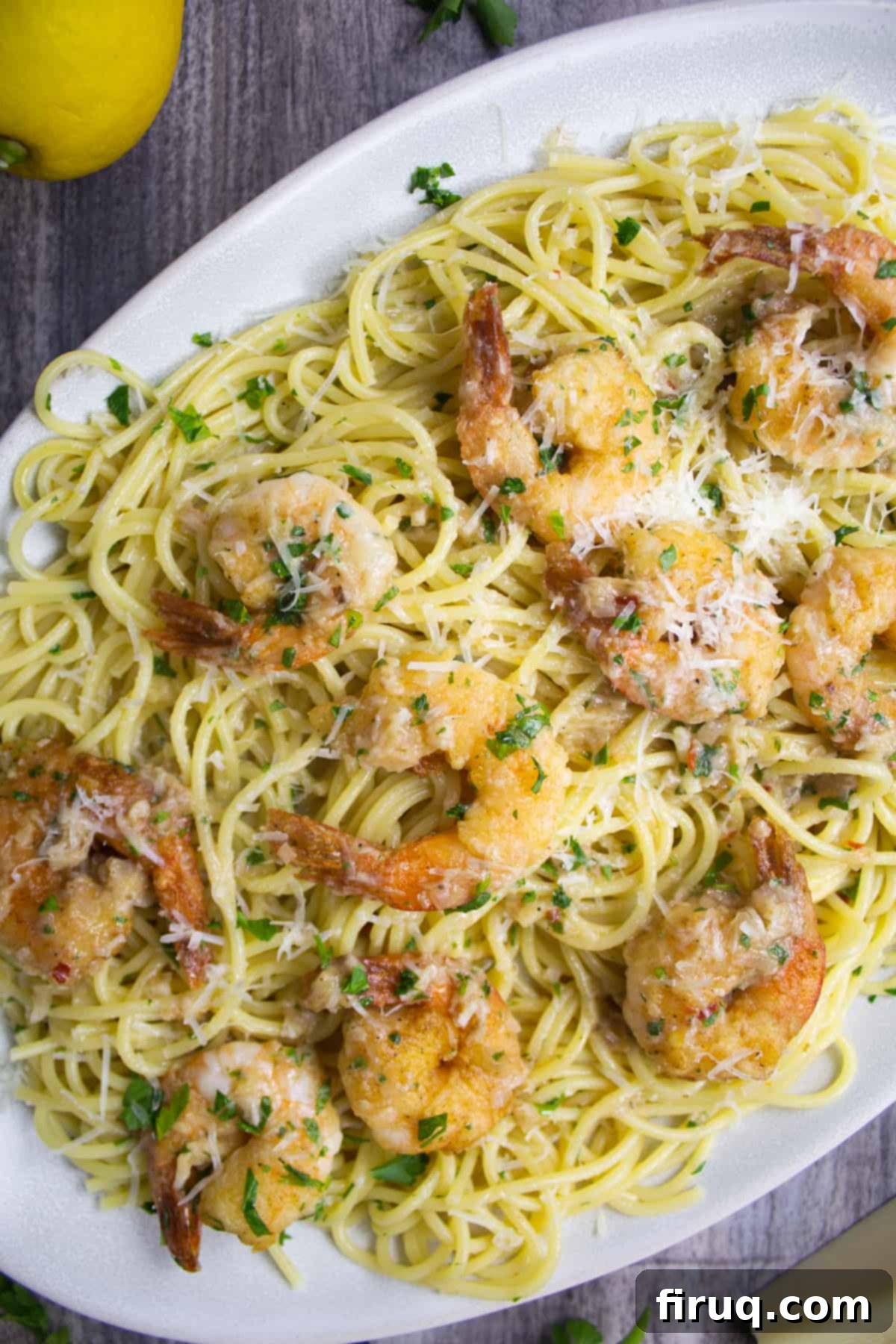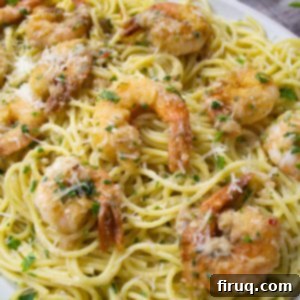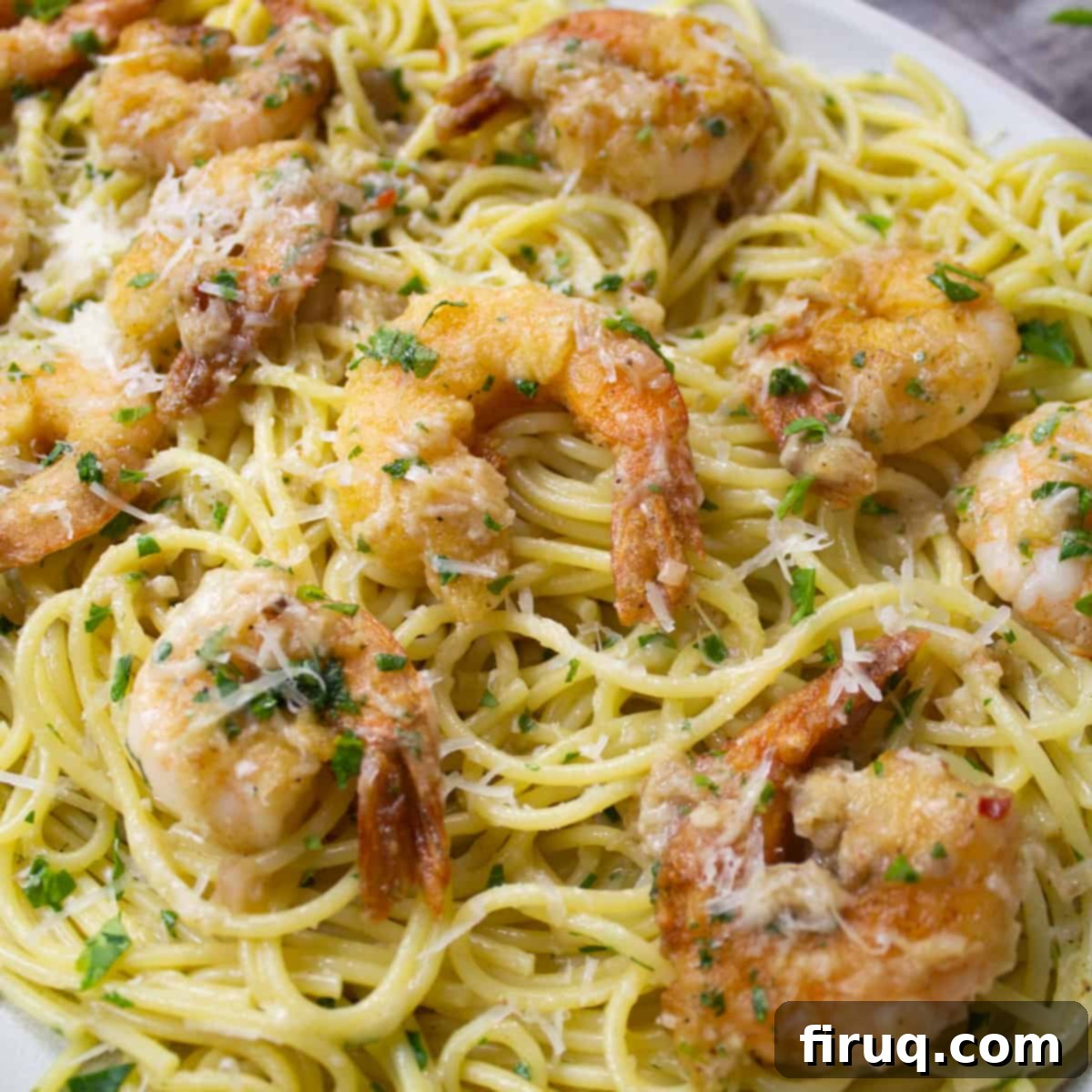Ultimate Wine-Free Shrimp Scampi: A Savory & Crispy Family Favorite
Discover the ultimate recipe for a delicious and savory shrimp scampi without wine, making this beloved dish accessible and incredibly easy for everyone. This unique rendition features perfectly battered and crispy shrimp paired with a vibrant, lemony pasta, creating a meal that the whole family will undoubtedly adore. Whether you’re avoiding alcohol, don’t have wine on hand, or simply prefer a different flavor profile, this recipe proves that you don’t need wine to achieve an incredibly rich and satisfying shrimp scampi.

Craving more fantastic pasta dishes with shrimp? Explore our other delectable recipes such as the bold and zesty Cajun Shrimp Scampi, the healthy and flavorful Low Carb Shrimp Scampi with Zoodles, or the spicy and robust Shrimp Fra Diavolo with Linguine.
The Fascinating Origins of Scampi
Shrimp scampi is a dish often at the center of a lively debate regarding its true culinary heritage. While it boasts definite Italian roots, the preparation we commonly recognize today in American cuisine has evolved significantly from its Mediterranean ancestors. Historically, the term “scampi” literally refers to Nephrops norvegicus, more commonly known as langoustines or Dublin Bay prawns – a species native to the Mediterranean and North Atlantic.
When this dish was first conceived in Italy, it was these delicate langoustines that were likely used, often simply prepared with olive oil, garlic, and lemon. Over time, as Italian immigrants brought their culinary traditions to America, langoustines were less readily available. Shrimp, being a more abundant and affordable alternative, took their place, and the dish adapted to local ingredients. Thus, “shrimp scampi” became a popular phrase, even though, literally translated, it means “shrimp cooked shrimp” or “shrimp langoustines.”
Regardless of its linguistic quirks or geographical evolution, every dish is a canvas open to interpretation and personal preference. Our version embraces this spirit, offering a unique take by introducing a crispy, battered texture to the shrimp and infusing the sauce with a powerful umami punch from anchovies, creating a truly unforgettable culinary experience.
Key Ingredients for a Flavorful Wine-Free Scampi
Crafting an exceptional wine-free shrimp scampi relies on smart substitutions and the masterful use of ingredients that build layers of complex flavor. Here’s a closer look at the stars of our recipe and how they contribute to its remarkable taste:
Substituting Wine with Chicken Broth and Lemon
Traditionally, white wine is a staple in shrimp scampi, lending acidity, depth, and a subtle sweetness. In this recipe, we ingeniously replace it with a harmonious combination of **chicken broth** and fresh **lemon juice**. Chicken broth provides a rich, savory base, while the lemon juice introduces that essential bright acidity that mimics the wine’s tang, balancing the richness of the butter and garlic. This ensures the sauce remains vibrant and complex without any alcohol.
The Umami Secret: Anchovies
For many, anchovies might seem an unusual addition to a shrimp scampi. However, these tiny fish are a secret weapon for adding incredible depth and a powerful “umami” flavor – often described as a savory, meaty taste – without making the dish taste overtly “fishy.” When finely chopped and sautéed, anchovies virtually melt into the sauce, releasing a profound savory richness that enhances every other ingredient. They are particularly crucial in a wine-free recipe, as they help to compensate for the flavor complexities typically contributed by the wine.
Battering the Shrimp: Our Signature Touch
While most shrimp scampi recipes call for sautéed or grilled shrimp, our approach takes a page from popular restaurant renditions (like The Cheesecake Factory’s famous shrimp) by **battering the shrimp**. This step results in shrimp that are wonderfully crispy on the outside and tender on the inside, adding a delightful textural contrast to the silky pasta. This method also creates a fantastic “fond” in the pan, which becomes the flavor foundation for our exquisite sauce.
Alternative Preparation: If frying isn’t your preference, you can certainly opt for a lighter preparation. Simply marinate the peeled and deveined shrimp in a mixture of olive oil, minced garlic, a pinch of salt, and black pepper for about 15-20 minutes. Then, sauté them in a hot pan with a little olive oil for 1-2 minutes per side, until pink and cooked through. Remove them from the pan and set aside before proceeding with the sauce, just as you would with the fried shrimp.
Step-by-Step Directions for Perfect Wine-Free Shrimp Scampi
The magic of this particular shrimp scampi lies in its unique preparation of the shrimp and the careful layering of flavors in the sauce. Follow these detailed steps to create a truly memorable meal:
Step 1: Prepare and Batter the Shrimp. Begin by ensuring your shrimp are peeled and deveined. In a shallow dish or plate, combine the flour with salt, black pepper, and garlic powder, mixing thoroughly to create a seasoned dredge. Lightly toss the cleaned shrimp in about 1 tablespoon of olive oil. Then, dredge each shrimp individually in the seasoned flour, ensuring an even, light coating. It’s crucial to perform this step right before you plan to fry the shrimp to prevent the flour from becoming gummy. Set the battered shrimp aside on a clean plate or wire rack.
Step 2: Fry the Battered Shrimp to Golden Perfection. Heat a large, sturdy pan (a cast-iron skillet works wonderfully here) over medium-high heat. Add enough olive oil to generously cover the bottom of the pan, about 2-3 tablespoons. Once the oil is shimmering and hot (you can test by flicking a tiny bit of flour into it; it should sizzle immediately), carefully arrange the battered shrimp in a single layer, ensuring there’s space between each piece to allow for even cooking. Fry for 1-2 minutes per side, until the batter is golden brown and crispy, and the shrimp are cooked through and opaque. Use tongs to gently flip the shrimp to avoid dislodging the delicate batter. You will likely need to fry the shrimp in batches to prevent overcrowding the pan. As each batch finishes, transfer the fried shrimp to a plate lined with paper towels to drain any excess oil, and set them aside.
Pro-Tips for Success
- Avoid Overcooking Shrimp: Shrimp cook very quickly, so keep a close eye on them. Overcooked shrimp become tough and rubbery. Aim for a maximum of 3 minutes of total cooking time (1-2 minutes per side), ensuring the batter is beautifully golden brown on each side.
- Gentle Handling is Key: The shrimp have a light batter, which can easily come off if handled too roughly. When flipping them, use tongs and be extra gentle, grasping them carefully rather than squeezing.
- Leverage the Fond: After frying the shrimp, don’t clean the pan! The flavorful bits (fond) left at the bottom of the pan are packed with deliciousness. Cook your sauce in the very same pan to scrape up these bits and infuse your sauce with an extra layer of savory depth.
Step 3: Prepare Your Pasta. While the shrimp are resting and before you start on the sauce, get a large pot of salted water boiling for your pasta. You want the pasta to finish cooking right around the same time your sauce is ready, ensuring it’s hot and perfectly al dente when combined with the sauce. Cook your chosen pasta according to package directions until al dente.
Step 4: Build the Flavorful Sauce Base. Reduce the heat under the pan to medium. It will still be quite hot from frying the shrimp, and it’s essential to let it cool slightly; adding butter too soon to a very hot pan can cause it to burn. Add 4 tablespoons of butter and 1 tablespoon of olive oil to the pan. Allow the butter to melt and any foam to dissipate. Add the minced shallots and chopped anchovy fillets. Sauté for 3-4 minutes, stirring frequently, until the shallots soften and the anchovies practically dissolve into the butter, infusing the pan with a rich, savory aroma. Next, add the minced garlic and 1 teaspoon of crushed red pepper (if desired for a hint of heat) and continue to sauté for another 2 minutes, being careful not to burn the garlic.
Step 5: Create the Tangy, Savory Sauce. Squeeze in the fresh lemon juice, stirring it throughout the shallot-anchovy-garlic mixture. Let it come to a gentle simmer for about 2 minutes, allowing the lemon to slightly reduce and its flavors to intensify. Then, pour in the chicken broth. Bring the mixture to a simmer, stirring often. Allow the sauce to gently reduce by about half, which typically takes 5-10 minutes. You’ll know it’s ready when you can drag your wooden spoon through the sauce, and it leaves a clear trail, much like “Moses parting the Red Sea.” This indicates a perfect, slightly thickened consistency.
Step 6: Combine and Serve. Before straining your al dente pasta, reserve about ½ cup of the starchy pasta cooking water. Add a splash of this reserved pasta water to your sauce, which helps to emulsify and thicken it slightly, making it wonderfully glossy. Let it return to a simmer briefly. Carefully add the fried shrimp to the sauce. Immediately follow with the strained pasta and the fresh chopped parsley. Gently toss and stir the pasta until it is thoroughly coated with the delicious sauce and the parsley is evenly distributed. Be mindful not to stir too vigorously, as you want to preserve the crispy coating on your shrimp. Serve the pasta immediately, generously garnished with freshly grated Parmesan cheese if you like!

Serving Suggestions and Variations
This wine-free shrimp scampi is a complete meal on its own, but it pairs beautifully with a few simple additions. Serve it alongside a fresh, crisp green salad with a light vinaigrette to cut through the richness of the pasta. A basket of warm, crusty garlic bread is also an excellent accompaniment, perfect for soaking up any leftover sauce.
Feel free to experiment with this recipe to suit your taste or what you have on hand:
- Add Vegetables: Stir in some cherry tomatoes during the last few minutes of the sauce’s simmer, or wilt in a handful of fresh spinach or arugula with the pasta.
- Different Pasta Shapes: While long pastas like spaghetti or linguine are traditional, this sauce also works wonderfully with shorter shapes like penne, rotini, or farfalle.
- Spice It Up: Increase the amount of crushed red pepper flakes for an extra kick of heat.
- Herb Boost: Add other fresh herbs like basil or oregano along with the parsley for a different aromatic profile.
Frequently Asked Questions About Wine-Free Shrimp Scampi
While you technically can, I highly recommend against it for this specific recipe. Without the depth that wine typically provides, the anchovies are crucial for bringing a profound savory and “umami” flavor to the dish. Rest assured, they melt away into the sauce and you won’t taste a distinct “fishy” flavor; instead, they elevate the overall deliciousness significantly. It’s a secret ingredient that truly makes this wine-free version shine.
As demonstrated in this recipe, chicken broth is an excellent and readily available substitute for white wine. When combined with fresh lemon juice, it perfectly mimics the acidity and savory depth that wine usually contributes, creating a well-balanced and flavorful sauce. We always keep chicken broth in the pantry, making it a convenient choice when white wine isn’t an option.
No, not in this dish. Apple cider vinegar has a much more intense and distinct flavor profile compared to white wine. It would likely overpower the delicate flavors of the shrimp, garlic, and lemon, and would not blend harmoniously with the overall dish. Stick to chicken broth and lemon juice for the best results.
Absolutely! Most shrimp available are frozen. Just ensure they are fully thawed before you begin cooking. The best way to thaw shrimp is overnight in the refrigerator, or for a quicker method, place them in a colander under cold running water for about 10-15 minutes until pliable. Make sure to pat them very dry before battering to ensure the flour adheres properly.
Yes, easily! Simply use your favorite gluten-free pasta (many excellent options are available that hold up well). For the battered shrimp, substitute the all-purpose flour with a gluten-free all-purpose flour blend or rice flour. The rest of the ingredients are naturally gluten-free.
Shrimp Scampi, in all its interpretations – Italian, American, Italian-American, or even with a British twist – remains a truly classic and beloved dish. It’s a testament to the power of simple, fresh ingredients coming together to create something extraordinary. This rendition of wine-free shrimp scampi is no exception, offering a savory, tangy, and utterly delicious experience that stands proudly alongside its traditional counterparts. The crispy battered shrimp adds a unique texture that will have you coming back for more!
If you loved this recipe and found it helpful, please consider leaving us a comment or a glowing review below! Your feedback helps us grow and inspires other home cooks. Follow us @vindelgiudice on Instagram or @alwaysfromscratch on Tiktok for more culinary inspiration and daily recipe ideas!
More Delightful Seafood Pasta Recipes
- Creamy Pesto Shrimp Pasta
- Linguine with Red Clam Sauce
- Lemon Pesto Spaghetti with Scallops
- Linguine with Clams
📖 Recipe

Shrimp Scampi Without Wine
Vincent DelGiudice
Pin Recipe
Equipment
-
1 large saucepan
-
1 large pot
Ingredients
- 1 lb shrimp, peeled and deveined
- 1 lb pasta
- 4 tablespoon butter
- 6 cloves garlic, minced
- 1 shallot, minced
- 4 anchovy filets, chopped
- 1 cup chicken broth
- 1 lemon, juiced
- ¼ cup parmesan
- ¼ cup fresh parsley, chopped
- ½ cup flour
- 1 teaspoon salt
- 1 teaspoon garlic powder
- 1 tsp black pepper
- 3-4 tbsp olive oil
- 1 teaspoon crushed red pepper
Instructions
-
In a shallow dish, combine ½ cup flour, 1 teaspoon salt, 1 teaspoon black pepper, and 1 teaspoon garlic powder. Toss the peeled and deveined shrimp in 1 tablespoon of olive oil, then dredge each shrimp in the seasoned flour mixture, ensuring an even coating. Set aside.
-
In a large pan (preferably a cast-iron skillet), add 2-3 tablespoons of olive oil and bring to medium-high heat until shimmering. Carefully arrange the battered shrimp in the pan in a single layer, leaving space between each. Fry for 1-2 minutes per side until golden brown and cooked through. Gently flip to avoid losing the batter. Fry in batches and set aside on a paper towel-lined plate.
-
Lower the heat to medium and allow the pan to cool slightly. Add 4 tablespoons of butter and 1 tablespoon of olive oil. Once the butter is melted and foamy, add the minced shallot and chopped anchovies. Sauté for 3-4 minutes, stirring, until the anchovies have almost melted into the butter. Then, add the minced garlic and 1 teaspoon of crushed red pepper (if using) and sauté for another 2 minutes until fragrant.
-
Meanwhile, in a large pot, bring generously salted water to a rolling boil. Cook 1 lb of spaghetti or your preferred pasta according to package directions until al dente. Reserve ½ cup of pasta water before draining.
-
Squeeze in the juice of 1 lemon into the sauce pan. Stir and let it gently simmer for about 2 minutes until it slightly thickens, and your spoon leaves a trail when dragged through. Add 1 cup of chicken broth to the pan. Bring it to a simmer, stirring often, and let the sauce reduce by about half, which should take 5-10 minutes.
-
Stir in a splash of the reserved pasta water into the sauce. Add the fried shrimp to the sauce. Then, add the drained pasta and ¼ cup fresh chopped parsley. Gently toss and combine well, ensuring the pasta is coated and the shrimp batter remains intact. Serve immediately with freshly grated Parmesan cheese, if desired.
Notes
- The shrimp are lightly battered, so gently flip them to make sure they don’t lose their batter during frying.
- For maximum flavor, cook the sauce in the same pan you fried the shrimp. This allows you to scrape up all the delicious “fond” (browned bits) from the bottom of the pan, adding incredible depth to your sauce.
Nutrition
